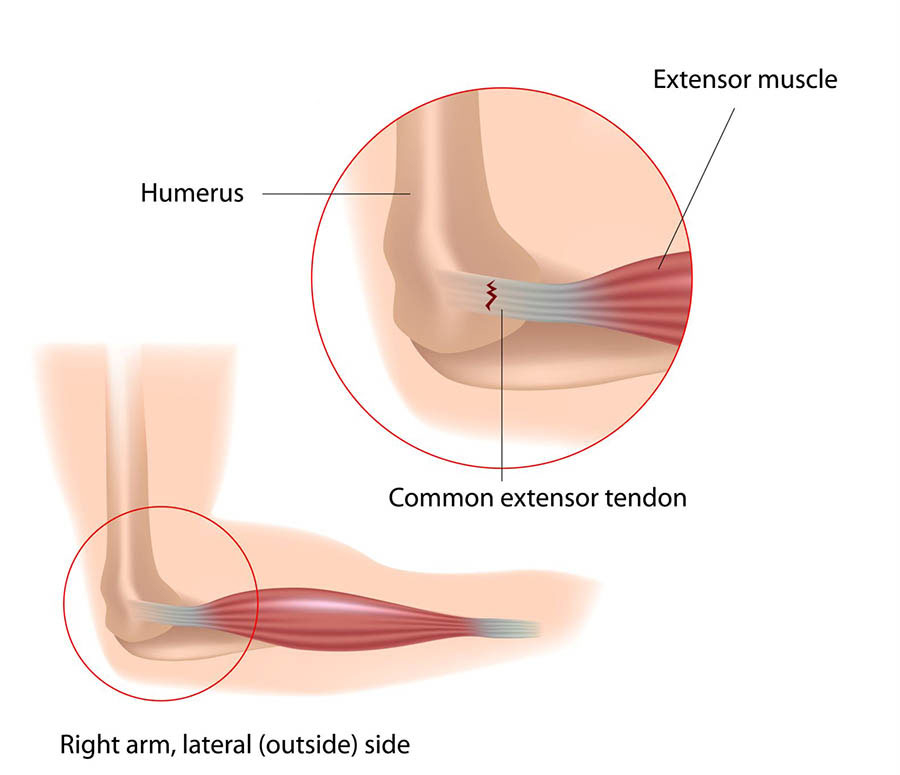Tennis elbow
Key facts
- Tennis elbow, or lateral epicondylitis, causes elbow pain and forearm weakness.
- It's caused by repeated use of your wrist or arm.
- Tennis elbow usually gets better on its own.
- You can prevent tennis elbow by keeping your arm properly positioned when you are at work or doing leisure activities.
What is tennis elbow?
Tennis elbow (lateral epicondylitis) causes elbow pain and forearm weakness. It's also called 'elbow tendinopathy'. It usually develops over time.
Tennis elbow is caused by a tear or swelling in the tendons that attach the muscle of the forearm to the bone in your upper arm. This is caused by repeated use of the muscles around the elbow.
Tendons are the fibrous bands that attach your muscles to your bones.
What are the symptoms of tennis elbow?
Tennis elbow can cause the outside of your elbow to feel sore. The pain can move to your upper arm and forearm.
The pain may start slowly or come on suddenly.
Other symptoms can include:
- weakness in your forearm
- swelling — if you have tendinitis (your tendon is inflamed)
It may hurt to do certain movements, like shake hands or turn a doorknob. Pressing on the outside of your elbow may make the pain worse.
CHECK YOUR SYMPTOMS — Use the Symptom Checker and find out if you need to seek medical help.
What causes tennis elbow?
Tennis elbow is caused by repeated use of your wrist or arm.
Tennis elbow occurs when there is damage to the tendon that connects the muscles of your forearm to the bone in your upper arm. This can be from activities like:
- playing tennis
- rowing
- using a screwdriver or hammer
- typing
- painting
- meat cutting
- plumbing
Other contributing factors include:
- using the wrong equipment — such as using a racquet that's too big
- poor physical form and condition
- playing on hard and fast surfaces
Tennis elbow occurs in about 2 in 100 people aged between 30 and 65 years. Smoking is also associated with the development of tennis elbow.

When should I see my doctor?
If you are worried that you have tennis elbow, see your doctor.
Also, see your doctor if:
- your arms or fingers have changes in sensation, including pins and needles
- your fingers or arm changes colour — to blue or white
- you have pain that is getting worse
- you have abnormal swelling around the affected area
- you have redness and heat in the area, or you develop fever-like symptoms
FIND A HEALTH SERVICE — The Service Finder can help you find doctors, pharmacies, hospitals and other health services.
ASK YOUR DOCTOR — Preparing for an appointment? Use the Question Builder for general tips on what to ask your GP or specialist.
How is tennis elbow diagnosed?
Your doctor will talk with you about your symptoms. They will also examine your arm.
The diagnosis of tennis elbow is usually made by physical examination, but sometimes an x-ray, ultrasound or even MRI may be needed. Your doctor may also measure your grip strength.
How is tennis elbow treated?
Tennis elbow usually gets better on its own. Try to stop doing whatever has caused your injury. Recovery can be slow, taking anywhere from 6 to 12 months.
To help your arm recover you can:
- rest your arm
- apply ice packs
- take a pain-relief medicine — oral ibuprofen should help
- keep active but try to avoid activities that make your arm hurt
Tennis elbow stretch
Hold your injured arm straight out and point your fingers down to the ground. Use your other hand to grab this hand — your thumb should be pressing on the palm of your hand.
Using your other hand, press down on the back of your hand to bend your wrist more. Hold this position for 30 seconds.
Repeat the stretch 3 times. Do this exercise every day.
Physiotherapy for tennis elbow
If your pain has not improved after 6 to 12 weeks, it's a good idea to see a physiotherapist. Some exercises can help reduce your pain more quickly and improve the use of your arm.
A physiotherapist can suggest exercises to stretch and strengthen the muscles in your arm.
They may recommend that you wear a brace or strap on your forearm to reduce stress on the painful area. They can also suggest changes in how you do certain tasks, to reduce the strain on your arm.
Steroid injection
If your pain and swelling doesn't get better with exercise, you may benefit from a steroid injection. This can help ease your pain. However, steroid injections don't stop you from getting tennis elbow again.
Surgery for tennis elbow
Surgery for tennis elbow is rarely needed but might be used if other treatments do not work.
There is a risk of decreased grip strength after surgery.
How is tennis elbow prevented?
You can prevent tennis elbow by keeping your arm properly positioned when you are at work or doing leisure activities. Try to keep your elbows slightly bent when you exercise or lift things.
Try to take regular breaks when you do activities where you move your elbow and wrist a lot. This is very important if the task involves repetitive movements.
Complications of tennis elbow
The main complication of tennis elbow is ongoing pain. Other complications can occur from treatments used to ease the pain.
Resources and support
You can call the healthdirect helpline on 1800 022 222 (known as NURSE-ON-CALL in Victoria). A registered nurse is available to speak with 24 hours a day, 7 days a week.
Learn more here about the development and quality assurance of healthdirect content.
Last reviewed: March 2024











